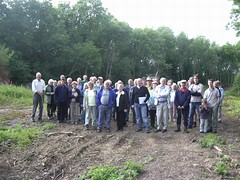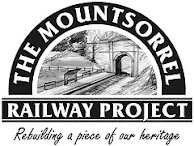Some readers may not be aware that the village once had its own railway: called the Mountsorrel Railway, it was built to serve the nearby granite quarries.
Local resident Steve Cramp is currently in the process of writing a book about the history of this industrial railway and is also heading up, on behalf of the Great Central Railway (GCR), a project to restore a section of the railway as a working museum of the important part the railway once played in Mountsorrel village life.
On July 8 Steve organised a historical walk along part of the disused railway trackbed. The purpose of the walk was to raise local awareness of the project, to allow local people a chance to learn about the railway’s history and to hear about the recreations that are planned for the rebuilt railway.
“I’m very pleased to be part of this project to restore part of the Mountsorrel Railway” said Steve. “18 months ago when I set out to research and write a book I never dreamt that I would actually end up being part of a volunteer community project to actually recreate Mountsorrel’s history”.
The walk was arranged at the suggestion of the Mountsorrel Heritage Group and was very well attended with over 50 people taking part. The group walked along the trackbed viewing the clearance work that has already been undertaken. Steve would stop at intervals to explain the various archaeology that still remains and also to talk about the recreations that are planned.

“Our recreations are quite ambitious” continued Steve. “I have put together what we term as the schools project”.
The schools project is a plan to involve children from the three local primary schools of Mountsorrel, Quorn and Rothley. “Far too much local history becomes lost as people grow old and are no longer with us” Steve continued. “If we can create an interest with our younger generation it may encourage them to ask more questions about the past and to look beyond the now to realise that Mountsorrel, and indeed the world, was once very different.
“We will go into the schools to explain about the railway and the effect it had on village life, in particular that of the children. We will also tell the children about the annual Sunday School excursions where the children would ride in the railway wagons, to the quarry owner’s house, where they would be entertained for the day. We hope to allow today’s children the chance to recreate a static version of this annual event in Mountsorrel’s history”.
The GCR plans to restore and repaint three historical railway wagons into the livery of the former Mountsorrel Granite company.
“15 competition winners from each school will be invited up to Rothley station where they will be allowed to get hands on with the restoration of the wagons under full supervision. When the wagons are eventually finished the children will be invited back dressed in Edwardian costumes. The wagons will be posed on a section of the rebuilt railway, we hope with the last surviving steam loco from the quarry – Elizabeth. The children will be allowed to sit in the wagons effectively recreating the Sunday School scene from 70-90 years ago. Old style black and white photos of the children will be taken and presented to the schools. We will also invite along any of the surviving children that rode in the original excursions of all those years ago.
“This is one of many recreations that will be possible. The GCR also hopes to run passenger trains on the rebuilt railway. Although passengers never rode on the railway originally, being able to on the rebuilt railway will be an interesting new attraction at the GCR. It also allows passengers to experience the history of the railway first hand” Steve explained.
The project seems to have captured the imagination of the local community with most of the volunteers working on the project living locally. “Most of our volunteers have become involved because of a desire to preserve Mountsorrel’s history. We have people of all ages from children right up to the age of 76 and of both sexes. We really seem to be a project for everyone.”
Restoration work has been swift with most of the trackbed now cleared and in the process of being prepared to receive track. The work is being undertaken entirely by unpaid volunteers in their spare time. If you would like to get involved then please contact Steve Cramp either at steve@mountsorrelrailway.org.uk or in the evenings on 0116 230 1374.
